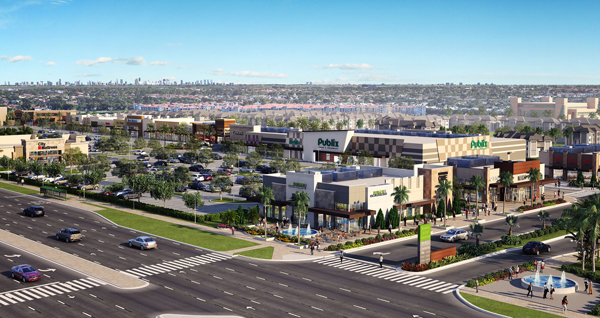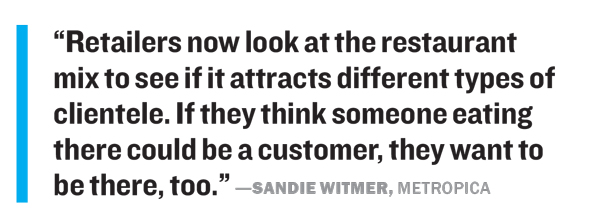Trending
The shoppers are coming

In pitching new retailers on why they need to open a location at Downtown Dadeland, Continental Real Estate Companies’ (CREC) Vice President Rafael Romero presents a flyer featuring photos of the well-known local chefs behind four restaurants that have opened in the past 18 months at the retail and residential development in Kendall.
Romero tells prospective tenants about how restaurants like Barley, an American Brasserie; Harry’s Pizzeria; Pubbelly Sushi; and Ghee Indian Kitchen are reshaping the 7.5-acre Downtown Dadeland into a destination that will draw in affluent consumers from throughout South Florida as well as those living in the immediate area, where the estimated median household income is $137,237.
“Those establishments are part of a concentrated effort to create a restaurant row that has completely revitalized Downtown Dadeland,” Romero said. “To get them, we went to every chef event we could find in South Florida. If there was a croquet contest and they were there, we were there, too.”
At a time when many brick-and-mortar brands continue downsizing or disappearing altogether from the American retail landscape, South Florida commercial brokers are courting tenants with sales pitches that focus on the region’s growing population and changing demographics.
The tri-county region added about 482,000 residents between 2010 and 2016, according to a March 2017 report by Florida International University analyzing recent U.S. Census figures. That growth has largely been fueled by immigrants — the university’s report found that net international migration to the region increased 397 percent in that period. It remains to be seen how President Trump’s immigration policies could affect this trend.
To land some tenants, the brokers are working with landlords to revamp existing properties and configure new developments into experiential destinations. They’re also giving start-up businesses and established brands short-term leases to test out empty storefronts. And some good old-fashioned networking helps to land deals, too.
“Cold-calling and being a voice on the phone is not enough,” Romero said. “You need to get in front of them, show them pictures and explain the vision to get them to buy in. It is more than just promoting a building. You have to create a scene for them.”
To be sure, retail real estate is performing better in South Florid than in other parts of the country. Colliers International’s second-quarter retail report showed Miami-Dade’s vacancy rate was just 3.8 percent, Broward’s was 3.7 percent, and Palm Beach’s was 4.5 percent. In comparison, the national retail vacancy rate rose to 10 percent in the same period, according to real estate research firm Reis Inc. And a recent report from online real estate marketplace Ten-X placed Miami and Fort Lauderdale in the first two slots of its top “Buy” markets for retail investors, forecasting that the metropolitan areas will experience a combined 14 percent growth in net operating income by year’s end.
However, local asking rents are growing at a slower pace than the 3 percent national rate, per JLL’s 2017 spring retail report for South Florida. In the second quarter of 2017, asking rents only ticked up 1 percent in Miami-Dade, 2 percent in Broward and 2.7 percent in Palm Beach. The brokerage also placed Miami, Fort Lauderdale and Palm Beach among 15 cities that have reached the peak of the market cycle.
A more anecdotal sign that South Florida is not immune to the shrinking base of department, apparel and accessory stores is the fact that brokers are concentrating more on fitness tenants like indoor cycling studios and fighting gyms as well as entertainment providers such as bowling alleys and luxury movie theaters .
 “There is not much deal flow for traditional apparel and trinket sellers,” Romero said. “These other categories have stepped in and given rise to the lifestyle center.”
“There is not much deal flow for traditional apparel and trinket sellers,” Romero said. “These other categories have stepped in and given rise to the lifestyle center.”
Robert Granda, commercial brokerage Franklin Street’s South Florida retail director, said he is advising landlords he works with to target start-up business owners doing old school concepts like luxury barbershops and cigar bars.
“It could be a barber from Los Angeles or New York who is looking to open his first location,” Granda said. “Typically, landlords would like to see a track record. I will tell them men’s grooming and barbershops are hot tenants because they provide services that are driven by the experience of being there.”
To attract a retailer, some landlords are willing to offer short-term leases for pop-up stores, says Rod Castan, president of leasing and management for Courtelis Company. The property owner gets to temporarily fill an empty space while the tenant gets to test out a storefront, he explained.
“You will see landlords willing to take chances on incubating a retail concept,” Castan said. “That is a method we have used in Florida’s softer markets.”
For instance, House 2 Home Goods — a tenant at the Shops of Surfside in Cape Coral — opened under a three-month lease in February but in May converted to a longer term agreement, Castan said. In Miami, French macaron maker Ladurée opened a permanent spot in the Design District in June 2016 after testing out a two-month pop-up inside the Chrome Hearts boutique at 4025 Northeast Second Avenue during 2015’s Art Basel.
In other instances, the national retail slowdown means Castan’s team has to make more cold calls and do more face-to-face meetings with potential tenants. “We are rolling up our sleeves and doing old-school leasing … Our agents are on the road almost every day visiting other shopping center and trade areas looking for potential tenants.”
The promise of a development that has a social center is what gets many retailers to sign on the dotted line.
In Pembroke Pines, Courtelis has been successful in preleasing 75 percent of the 300,000-square-foot retail, entertainment and restaurant space at Pines City Center. Developed by Terra Group, the 47-acre mixed-use development is being built in two phases, with the first scheduled for completion by 2018. Major tenant signings include Publix, Carl’s Patio, Cooper’s Hawk, BurgerFi and Outback Steakhouse.
“These types of projects tend to have more attractive common areas and are better gathering places from a development standpoint compared to traditional shopping centers,” Castan said. “Bringing in ethnic, fast casual and healthy dining concepts is another way to make the projects more successful.”
Castan said he and his team show potential tenants renderings of Pines City Center to point out the features that will draw people in. “The center has transitional plazas between buildings and attractive rotundas, and the parking areas are planned to be more pedestrian-friendly,” he says. “These areas create gathering spaces where we can have pop-ups, art exhibits, music and other features that will make the shopping center more interesting to visit.”
Another large-scale mixed-use development that is following a similar retail recruitment strategy is Metropica, which has leased about half of its 485,000 square feet of retail. In all, the 4 million-square-foot development in Sunrise will have more than 2,200 residential units in addition to retail, dining and entertainment space, a wellness and fitness facility, a park and other recreational amenities.
“In the past, landlords would need a department store or a big box retailer as an anchor tenant,” says Sandie Witmer, in-house director of retail leasing for Metropica. “Today, the environment you create is the anchor.”
Witmer’s leasing team has been working on a curated restaurant collection as one of Metropica’s “environment anchor” concepts. “Retailers now look at the restaurant mix to see if it attracts different types of clientele,” Witmer says. “If they think someone eating there could be a customer, they want to be there, too.”
Using this strategy, the $1.5 billion megadevelopment has signed popular eateries like Harry’s Pizzeria, Bulla Gastrobar, Shake Shack and Fogo de Chao to go alongside entertainment tenants iPic Theaters and Kings Bowl and retailers such as Anthropologie and Kendra Scott Jewelry.
So far, retail leasing in South Florida remains strong enough and vacancy rates are low enough that brokers and landlords don’t need to offer “crazy concessions,” said CREC’s Romero.
“We’ve been in the single digits for a very long time,” he said. “Retail is very much alive.”




